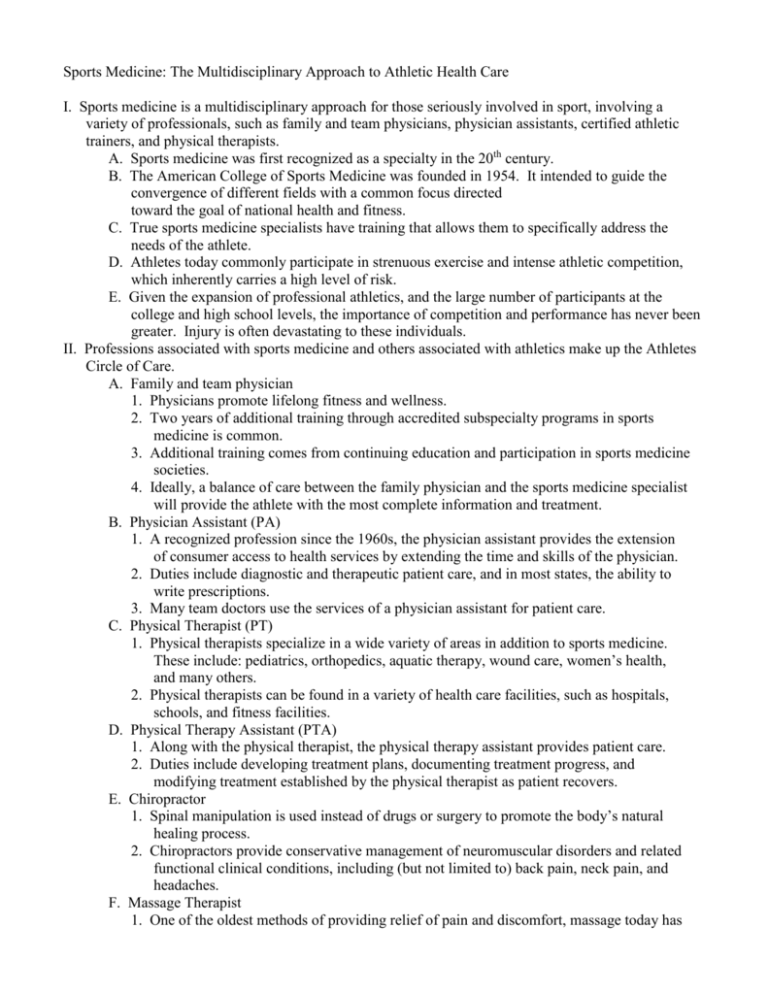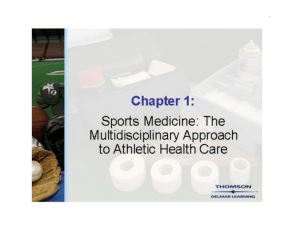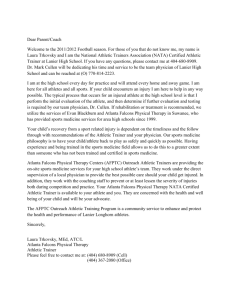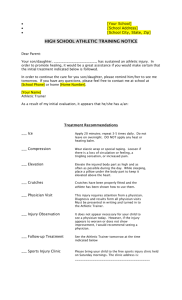Sports Medicine: The Multidisciplinary Approach to Athletic Health
advertisement

Sports Medicine: The Multidisciplinary Approach to Athletic Health Care I. Sports medicine is a multidisciplinary approach for those seriously involved in sport, involving a variety of professionals, such as family and team physicians, physician assistants, certified athletic trainers, and physical therapists. A. Sports medicine was first recognized as a specialty in the 20th century. B. The American College of Sports Medicine was founded in 1954. It intended to guide the convergence of different fields with a common focus directed toward the goal of national health and fitness. C. True sports medicine specialists have training that allows them to specifically address the needs of the athlete. D. Athletes today commonly participate in strenuous exercise and intense athletic competition, which inherently carries a high level of risk. E. Given the expansion of professional athletics, and the large number of participants at the college and high school levels, the importance of competition and performance has never been greater. Injury is often devastating to these individuals. II. Professions associated with sports medicine and others associated with athletics make up the Athletes Circle of Care. A. Family and team physician 1. Physicians promote lifelong fitness and wellness. 2. Two years of additional training through accredited subspecialty programs in sports medicine is common. 3. Additional training comes from continuing education and participation in sports medicine societies. 4. Ideally, a balance of care between the family physician and the sports medicine specialist will provide the athlete with the most complete information and treatment. B. Physician Assistant (PA) 1. A recognized profession since the 1960s, the physician assistant provides the extension of consumer access to health services by extending the time and skills of the physician. 2. Duties include diagnostic and therapeutic patient care, and in most states, the ability to write prescriptions. 3. Many team doctors use the services of a physician assistant for patient care. C. Physical Therapist (PT) 1. Physical therapists specialize in a wide variety of areas in addition to sports medicine. These include: pediatrics, orthopedics, aquatic therapy, wound care, women’s health, and many others. 2. Physical therapists can be found in a variety of health care facilities, such as hospitals, schools, and fitness facilities. D. Physical Therapy Assistant (PTA) 1. Along with the physical therapist, the physical therapy assistant provides patient care. 2. Duties include developing treatment plans, documenting treatment progress, and modifying treatment established by the physical therapist as patient recovers. E. Chiropractor 1. Spinal manipulation is used instead of drugs or surgery to promote the body’s natural healing process. 2. Chiropractors provide conservative management of neuromuscular disorders and related functional clinical conditions, including (but not limited to) back pain, neck pain, and headaches. F. Massage Therapist 1. One of the oldest methods of providing relief of pain and discomfort, massage today has become important in promoting wellness and reducing stress. 2. Massage therapists work along with physicians, nurses, and physical therapists in the promotion of health and healing. G. Certified Strength and Conditioning Specialist/Personal Trainer 1. Fitness instructors monitor and modify the athlete’s conditioning and strength training. 2. There are currently 4 accredited certifications for the personal trainer credential: the Certified Strength and Conditioning Specialist (CSCS), the National Strength and Conditioning Association Certified Personal Trainer (NSCA-CPT), the American Council on Exercise (ACE), and the National Academy of Sports Medicine (NASM). 3. The certified athletic trainer can work with skilled strength and conditioning specialist to design specific workouts to fit an individual athlete’s needs. H. Sports Nutritionists 1. Nutritionists develop correct diets for athletic competitors, and instruct athletes on supplements and dietary aids. 2. Improvement in performance can be achieved through special diets geared toward specific athletic events. I. Sports Psychologist 1. Sports Psychologist are specially trained in athletic motivation and performance. Goal setting and imagery are two techniques used to give athletes an edge. 2. Sports psychologists can be found in clinical settings, educational institutions, private practice, and employed by professional sports teams. J. The Role of Coaches in the Athlete’s Circle of Care 1. At all levels, from youth league competitions to professional sports teams, coaches teach athletes how to compete without injury. 2. God communications between coach, athlete, and certified athletic trainer will ensure the best care for all athletes. K. The Role of the Parents in the Athlete’s Circle of Care 1. Parents should be actively engaged in the prevention and treatment of their children’s injuries. 2. Parents can be directly involved with sports medicine specialists, provide education to their children, and be active in providing proper nutrition and conditioning.








